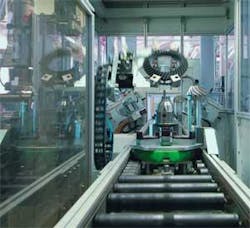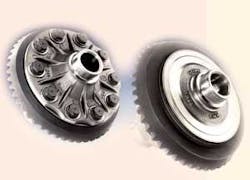Munich, Germanyndash;An innovative project undertaken by BMW Group’s Research and Innovation Center was the creation of laser welding joints to replace the traditional nut and bolt connection of the ring gear and differential housing in the rear axle gear. Through an intensive cooperation between the center, located here, and BMW’s Dingolfing plant, under the guidance of mechanical engineer Dr. Tim Angerer, this project was developed for mass production.
In the axle differential gear, there is a meeting of case-hardened steel and cast ironndash;two materials that just a few years ago were considered taboo in welding. The welding processes are much harder to control because the high carbon content in the two components results in cold cracks. But a new laser welding method that adds wire containing nickel now allows these materials to be joined. A feasibility study tested the new welding process with respect to durability and distortion in particular. The decision was made to use this process on the components commonly known as the differential.
Traditionally, nuts and bolts are used to join the ring gear and differential housing. But they add weight and take up space, and reducing weight, especially for rotating parts, is an important task in the automotive industry. Less weight can translate into significant reductions in fuel consumption and CO2 emissions. “Eliminating the [nuts and bolts] is not the only factor reducing costs and weight,” explains Dr. Angerer. “There are additional weight and space benefits resulting from the laser specific designndash;what you might call a double effect from laser welding. We were also able to improve the efficiency of the axle gear.” When they eliminated the nuts and bolts and the associated high flange with its ribbing, there was a reduction in resistance and turbulence in the transmission oil bath.
Process developmentndash;done in cooperation with the TRUMPF Application Center (Ditzingen, Germany)ndash;presented a wide variety of challenges to the engineers in Munich and Dingolfing. Tests were conducted to optimize a range of parameters, such as the composition and diameter of the filler wire, weld seam preparation, laser power, focus location, and welding speed. The engineers repeatedly subjected the components to stress and quality testing. The welding joint proved to be especially durable. “Until now, we had no way of testing the upper stress limits of our weld seams,” says Dr. Angerer.
While the development process was underway, BMW had already begun planning the plant layout. “Since there were ongoing changes in the process and design of components, we got an early start with the coordination of process development and plant layout,” remembers Dr. Angerer. “By mid-2005, we were able to order a laser welding center with three automatic loading and unloading devices and three welding stations from TRUMPF. We then put them into operation at the Dingolfing plant in the spring of 2006.” The system allows rear and front gears to be welded in what is called a “chaotic system.” In addition, several steps were integrated, such as the cleaning or quality control of the weld seams.
Dr. Angerer calculates that the return on investment for development costs will be quickly realized. “We have also acquired expertise that we can use in other applications,” explains the project manager. For more information, contact Dr. Tim Angerer, BMW Group, at [email protected].
Blind man ‘sees’ new home through SLS model
Lousiville, KYndash;The University of Louisville’s Rapid Prototyping Center (RPC) and Harvest Technologies (a 3D Systems preferred parts service provider) teamed to create stereolithography (SLA) and selective laser sintering (SLS) models of a home here for a family featured on ABC’s “Extreme Makeover: Home Edition.”
Nineteen-year-old Patrick Henry Hughes, the family’s eldest son, is blind and disabled. In just seven days, the “Extreme Makeover” team rebuilt the Hughes family home to be safe and wheelchair accessible. Due to his blindness, Patrick Henry would have no idea what the house looked like or understand the floor plan to get around.
Models of the home were built with 3D Systems’ technology by the University’s RPC and Harvest. Patrick Henry was given the DuraForm PA and Accura 25 models so he could “see” the shape and layout through touch at the same time the crowd chanted “move that bus” and his family was experiencing the thrill of visually seeing their new, improved home.
The University’s RPC created a three-dimensional CAD model from two-dimensional design layouts of the home. It then built a scaled-down physical model of the home with 3D Systems’ rapid prototyping and manufacturing technology. The additive manufacturing process cures a liquid resin (SLA) or sinters plastic powders (SLS) into solid cross-sections, layer by layer, until a three-dimensional part is built. It took 22 hours to build the 18 x 15 x 7in. model and another 10 hours for finishing touches.
Concurrently, Harvest Technologies built a slightly larger three-piece model of the home. The roof and ceiling were made with Accura 25 plastic, a flexible material that simulates the aesthetics and properties of polypropylene, on a 3D Systems’ Viper Pro SLA system. A Sinterstation Pro SLS system, known for its high throughput and speed, created the body of the housendash;built in Duraform PA plastic.
The RPC model now sits in Patrick Henry’s bedroom, while the construction company, Elite Homes, is displaying the Harvest model with plans to paint it to look like a miniature version of the house.
For more information about the University of Louisville’s RPC, visit http://louisville.edu/speed/rpc. For information on Harvest Technologies, visit www.harvest-tech.com.
Laser welding works of art
Londonndash;Artist Damien Hirst’s diamond-encrusted skull officially became the world’s most expensive piece of contemporary art after it was bought in August 2007 by an unnamed investment group for £50 million. The skull, entitled “For the Love of God,” was created for Hirst by Bentley & Skinner of Bond Street, London, using more than 8601 of the world’s most perfect, flawless diamonds and 2156 grams of platinum welded using laser. The creation of the piece took 18 months of hard work, and the skull has the distinction of being the largest diamond piece commissioned since the Crown Jewels.
An original 18th century skull of a mid-30-year-old man was used to make a cast before 32 individual platinum plates were created and subsequently joined together using a Rofin (Daventry, Northamptonshire, UK; www.rofin.co.uk) StarWeld Performance laser welding system. The welding process was repeated until all of the 32 plates were joined, forming the setting piece for the diamonds.
Manual laser welding allows platinumndash;and other precious metals such as gold, silver, stainless steel, and titaniumndash;to be joined together without the use of soldering. A laser weld is strong and pure even in areas where it would be hard to gain access using other joining techniques.



